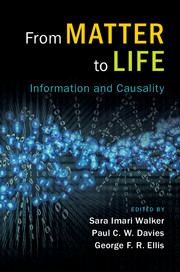Book contents
- Frontmatter
- Contents
- About the authors
- 1 Introduction
- Part I Physics and Life
- Part II Bio from Bit
- 4 (How) Did Information Emerge?
- 5 On the Emerging Codes for Chemical Evolution
- 6 Digital and Analogue Information in Organisms
- 7 From Entropy to Information: Biased Typewriters and the Origin of Life
- Part III Life's Hidden Information
- Part IV Complexity and Causality
- Part V From Matter to Mind
- Index
7 - From Entropy to Information: Biased Typewriters and the Origin of Life
from Part II - Bio from Bit
Published online by Cambridge University Press: 02 March 2017
- Frontmatter
- Contents
- About the authors
- 1 Introduction
- Part I Physics and Life
- Part II Bio from Bit
- 4 (How) Did Information Emerge?
- 5 On the Emerging Codes for Chemical Evolution
- 6 Digital and Analogue Information in Organisms
- 7 From Entropy to Information: Biased Typewriters and the Origin of Life
- Part III Life's Hidden Information
- Part IV Complexity and Causality
- Part V From Matter to Mind
- Index
Summary
So much has been written about the possible origins of life on Earth (see, e.g., the popular books by Deamer, 1994; deDuve, 1995; Koonin, 2011; Morowitz, 2004) that it sometimes seems that – barring an extraordinary breakthrough in experimental biochemistry (e.g., Patel et al., 2015), or the discovery of the remnants of an ancient biochemistry (Davies et al., 2009) – nothing new can be said about the problem. But such a point of view does not take into account that perhaps not all the tools of scientific inquiry have been fully utilized in this endeavor to unravel our ultimate origin on this planet. Indeed, originof- life research has historically been confined to a fairly narrow range of disciplines, such as biochemistry and geochemistry. Today, amuch broader set of tools is being unleashed on this problem, including mathematical (England, 2013; Smith, 2008; Vetsigian et al., 2006) and computational approaches (Mathis et al., 2015; Nowak and Ohtsuki, 2008; Segre et al., 2000; Vasas et al., 2012; Walker et al., 2012). Computational approaches to the study of possible origins of life are often derided because they lack a particular feature of biochemistry, or “because they do not take into account the specific properties of individual organic compounds and polymers” (Lazcano and Miller, 1996). Such a point of view ignores the possibility that life may be not a feature that is dependent on a particular biochemistry (Benner et al., 2004), but could instead be a feature of any chemistry that is capable of encoding information.
If the one invariant in life is information (information about how to replicate, that is), it then becomes imperative to understand the general principles by which information could arise by chance. It is generally understood that evolution, viewed as a computational process (Adami, 1998; Mayfield, 2013), leads to an increase in information on average. The amount of information that evolution has accumulated to date differs from organism to organism, of course, and precise numbers are not known. A rough estimate of the amount of information stored in an organism's genome can be obtained by calculating the amount of functional DNA in an organism.
- Type
- Chapter
- Information
- From Matter to LifeInformation and Causality, pp. 130 - 154Publisher: Cambridge University PressPrint publication year: 2017
- 3
- Cited by



